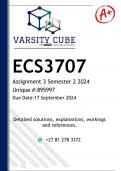ECS3707
Assignment 3 Semester 2 2024
Unique #:895997
Due Date:17 September 2024
Detailed solutions, explanations, workings
and references.
+27 81 278 3372
, QUESTION 1
1.1.
GDP per capita, the Human Development Index (HDI), and the Multidimensional
Poverty Index (MPI) are commonly used to assess a country's development, but
each captures different dimensions of progress, offering unique insights into the
quality of life and development challenges.
GDP per capita, calculated by dividing a nation's total gross domestic product by
its population, measures the average income or economic output per person. It is
primarily an economic indicator that reflects the market value of all goods and
services produced within a country in a given period. While GDP per capita
provides a snapshot of economic activity and potential for material wealth, it has
significant limitations. It does not consider income distribution, inequality, or non-
market activities, such as unpaid care work or the informal economy (Stiglitz, Sen
& Fitoussi, 2009). Furthermore, GDP per capita does not account for environmental
degradation or the sustainability of growth, making it a limited tool for measuring
broader development outcomes.
In contrast, the Human Development Index (HDI) offers a more comprehensive
view by incorporating three dimensions: health (measured by life expectancy at
birth), education (measured by mean years of schooling and expected years of
schooling), and standard of living (measured by Gross National Income per capita).
The HDI is a composite index that captures not only economic prosperity but also
social indicators, making it a more holistic measure of development than GDP per
capita. However, despite its broader scope, the HDI has been critiqued for
oversimplifying complex dimensions of human development into a single index,
which can mask underlying disparities within countries (Klugman, 2011).
The Multidimensional Poverty Index (MPI), developed by the Oxford Poverty and
Human Development Initiative, further expands the concept of development by
measuring poverty through ten indicators across three dimensions: health,
education, and living standards. These indicators include factors such as child
mortality, malnutrition, years of schooling, access to clean water, sanitation, and
electricity. Unlike GDP per capita and HDI, which focus on national averages, the
MPI emphasizes the lived experiences of the poor and highlights deprivations
Varsity Cube 2024 +27 81 278 3372
, across multiple dimensions, providing a granular understanding of poverty (Alkire
& Foster, 2011). The MPI offers insights into how people are impacted by various
forms of deprivation that go beyond income, thus enabling policymakers to design
targeted interventions.
In conclusion, while GDP per capita serves as a useful measure of economic
activity, it fails to capture the social, environmental, and distributive aspects of
development. The HDI offers a broader perspective by integrating health and
education, but it remains somewhat limited in addressing inequality. The MPI, with
its multidimensional approach, presents the most comprehensive picture of human
well-being, recognizing that poverty and development are multifaceted issues. To
fully understand development progress, policymakers should consider using these
broader indices alongside GDP per capita (Alkire & Foster, 2011).
1.2.
Gross Domestic Product (GDP) per capita, which measures a country's average
economic output per person, has been a widely used indicator of development.
However, this metric is often critiqued for its narrow focus on economic growth,
which may not adequately capture the well-being or quality of life of individuals.
Amartya Sen's capability framework challenges the reliance on GDP per capita as
a sole indicator of development by emphasizing that development is not just about
economic output but about expanding people's substantive freedoms and
capabilities to lead lives they value (Sen, 1999).
One of the strengths of GDP per capita is its ability to provide a snapshot of a
country's economic performance, which is crucial for policymakers and investors.
It is easy to compute, allowing for comparisons across time and between countries.
Higher GDP per capita generally suggests that a country has more resources to
invest in public goods, such as healthcare, education, and infrastructure, which are
essential for improving living standards (Todaro & Smith, 2015). Additionally, it
serves as an indicator of economic growth, which is often a prerequisite for
development, especially in countries that are struggling to meet basic material
needs.
Varsity Cube 2024 +27 81 278 3372




